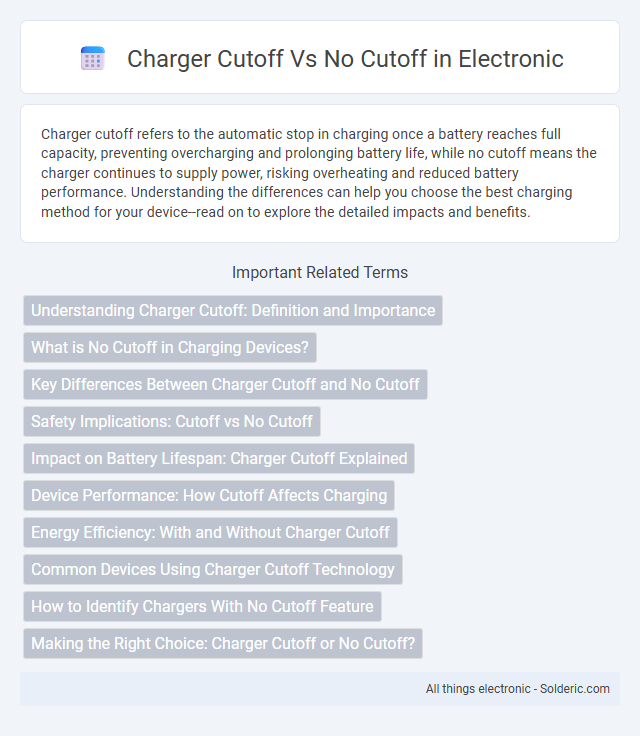Charger cutoff refers to the automatic stop in charging once a battery reaches full capacity, preventing overcharging and prolonging battery life, while no cutoff means the charger continues to supply power, risking overheating and reduced battery performance. Understanding the differences can help you choose the best charging method for your device--read on to explore the detailed impacts and benefits.
Comparison Table
| Feature | Charger Cutoff | No Cutoff |
|---|---|---|
| Battery Protection | Prevents overcharging; extends battery lifespan | Risk of overcharging; reduces battery lifespan |
| Energy Efficiency | Stops power flow when fully charged; saves energy | Continuously draws power; wastes energy |
| Device Safety | Minimizes overheating and potential damage | Higher risk of overheating and damage |
| Charging Speed | Automatic cut-off; may slightly extend charge time | Continuous charging; could be faster but unsafe |
| User Convenience | Stops charging automatically; less monitoring required | Users must manually disconnect to avoid damage |
Understanding Charger Cutoff: Definition and Importance
Charger cutoff refers to the point at which a charger stops supplying power to a device to prevent overcharging, ensuring battery longevity and safety. Without charger cutoff, batteries risk overheating, reduced lifespan, or potential damage due to continuous charging. Understanding this mechanism is crucial for optimizing device performance and maintaining battery health.
What is No Cutoff in Charging Devices?
No Cutoff in charging devices means the charger continues to supply power even after the battery reaches full capacity, which can lead to overcharging and reduced battery lifespan. Charger cutoff technology stops the power flow once the battery is fully charged, preventing overheating and extending battery health. Understanding the difference helps you choose a charger that optimizes battery safety and longevity.
Key Differences Between Charger Cutoff and No Cutoff
Charger cutoff stops power flow once the battery reaches full charge, protecting battery health and preventing overcharging, while no cutoff allows continuous charging, risking overheating and reduced battery lifespan. Devices with charger cutoff enhance safety and energy efficiency by automatically disconnecting, whereas those without may cause accelerated battery degradation and potential safety hazards. Your choice impacts device longevity and charging safety, making charger cutoff a crucial feature for reliable battery management.
Safety Implications: Cutoff vs No Cutoff
Charger cutoff technology significantly enhances safety by preventing overcharging and reducing the risk of battery overheating or fire. Without cutoff, continuous charging can lead to battery degradation, swelling, and potential hazards due to prolonged current flow. Ensuring your charger includes a cutoff feature protects both your device's lifespan and your personal safety during charging sessions.
Impact on Battery Lifespan: Charger Cutoff Explained
Charger cutoff technology enhances battery lifespan by preventing overcharging, which reduces stress on lithium-ion cells and minimizes capacity degradation over time. Without charger cutoff, batteries remain at full charge longer, accelerating chemical wear and diminishing overall longevity. Implementing charger cutoff effectively maintains optimal charge levels, preserving battery health and extending usable life cycles.
Device Performance: How Cutoff Affects Charging
Charger cutoff technology protects your device by stopping the charging process once the battery reaches full capacity, preventing overcharging and potential overheating. Without cutoff, continuous charging can degrade battery health, reduce overall performance, and shorten device lifespan. Using a charger with cutoff ensures efficient energy management, maintaining optimal device functionality and prolonging battery life.
Energy Efficiency: With and Without Charger Cutoff
Charger cutoff technology enhances energy efficiency by preventing overcharging and reducing power loss during the battery charging process, leading to lower electricity consumption and prolonging battery lifespan. Without charger cutoff, devices may continue to draw power even after reaching full charge, resulting in energy waste and higher utility costs. Implementing charger cutoff mechanisms ensures optimal energy use and supports sustainable charging practices by minimizing unnecessary energy discharge.
Common Devices Using Charger Cutoff Technology
Common devices using charger cutoff technology include smartphones, laptops, and electric vehicles, which rely on this feature to prevent overcharging and extend battery lifespan. Smart power banks and wearable devices also implement charger cutoff mechanisms to optimize energy efficiency and ensure user safety. This technology is critical in mitigating risks associated with battery overheating and preserving overall device performance.
How to Identify Chargers With No Cutoff Feature
Chargers with no cutoff feature continue supplying power even after a device reaches full charge, posing risks like battery overheating or reduced lifespan. To identify these chargers, check for product specifications mentioning terms like "automatic cutoff," "overcharge protection," or "smart charging" on packaging or in the user manual. An absence of these keywords, along with a simple design lacking LED indicators or smart sensors, usually indicates a charger without a cutoff feature.
Making the Right Choice: Charger Cutoff or No Cutoff?
Choosing between a charger cutoff and no cutoff depends on balancing battery health and charging convenience. Charger cutoff prevents overcharging by automatically stopping the power flow once your device reaches 100%, which can extend battery lifespan and reduce energy waste. Without cutoff, chargers continue to supply power, risking potential overheating and shorter battery life, so your decision should consider the device's specifications and your charging habits.
Charger cutoff vs No cutoff Infographic

 solderic.com
solderic.com